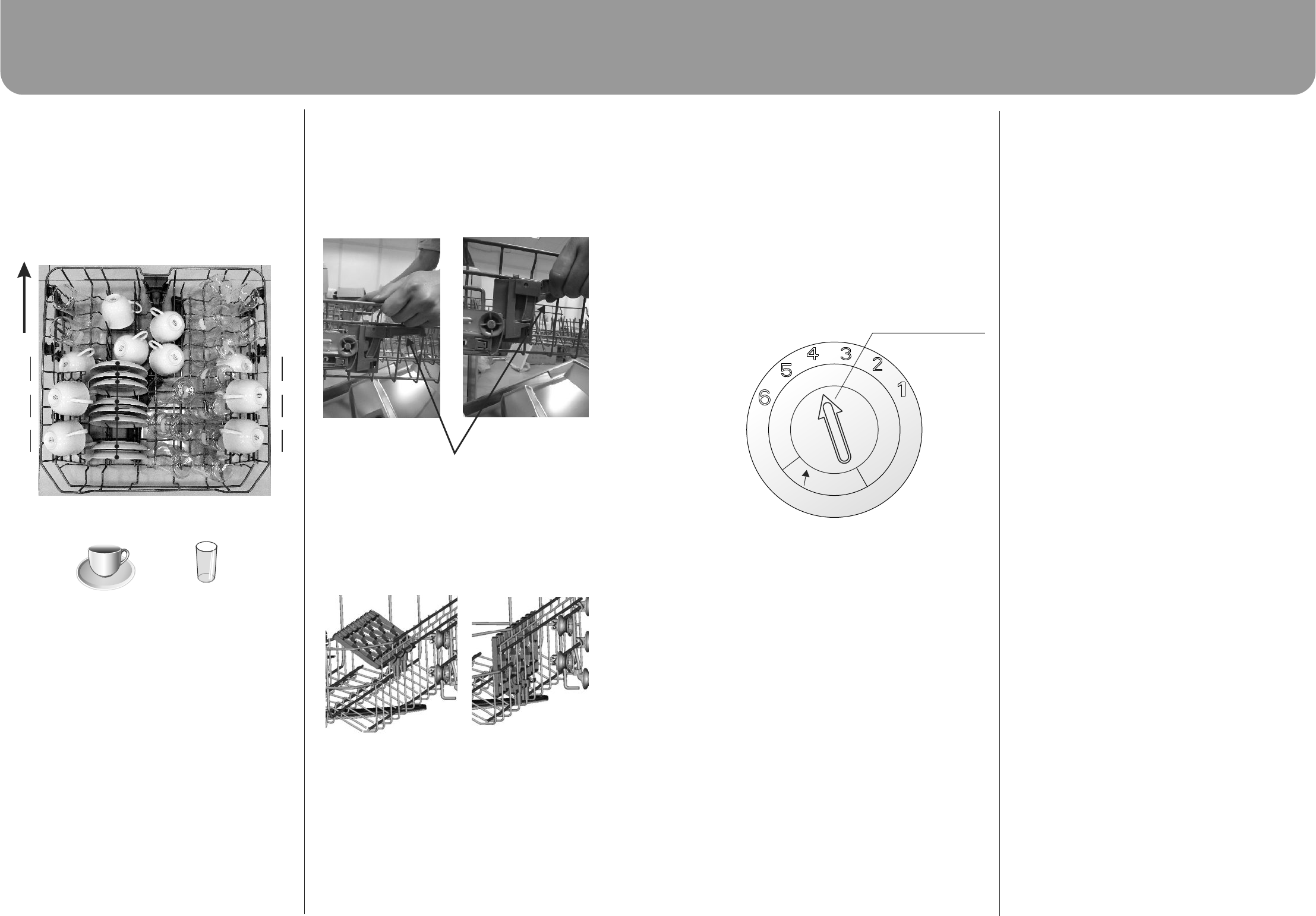
Using Your Dishwasher
Page 13Page 16
Using Your Dishwasher
Loading the Upper Basket
The upper basket is designed to hold more delicate
and lighter dishware such as glasses, coffee and tea
cup and saucers, as well as plates, small bowls and
shallow pans (as long as they are not too dirty).
Position the dishes and cookware so that they do not
get moved by the spray of water.
Folding back the cup shelves
For reduced loads, the additional cup shelves can
be folded down if not required as shown below.
Adjusting the Upper Basket
The height of the upper basket can be adjusted in
order to create more space for large utensils both
for the upper/lower basket. The height of the upper
basket can be adjusted by lifting the handle on
either side of the basket, see pictures below:
Lower position
Upper position
IN
c
Glasses
Saucers
b
Cups
a
Please be reminded that:
Pots, serving bowls, etc, must always be placed
top down.
Deep pots should be slanted to allow water to
flow out.
The Bottom Basket features folding spikes so
that larger or more pots and pans can be loaded.
Ÿ
Ÿ
Ÿ
a
a
a
a
a
c
c
c
c
c
c
c
c
c
a
a
a
a
a
a
b
c
c
c
c
c
a
a
a
Adjustment Handle
Adjusting the Rinse Aid Dispenser
The rinse aid dispenser has six or four settings. Always
start with the dispenser set on "4". If spots and poor
drying are a problem, increase the amount of rinse aid
dispensed by removing the dispenser lid and rotating
the dial to "5". If the dishes are still not drying properly
or show spots, adjust the dial to the next higher level
until your dishes are spot free. The recommended
setting is "4". (Factory value is "4".)
NOTE: Increase the dose if there are drops of water or
lime spots on the dishes after washing. Reduce it if
there are sticky whitish stains on your dishes or a
bluish film on glassware or knife blades.
Detergents
There are 3 sorts of detergents:
1. With phosphate and with chlorine
2. With phosphate and without chlorine
3. Without phosphate and without chlorine
Normally new pulverised detergent is without
phosphate. Thus the water softener function of
phosphate is not given. In this case we recommend to
fill salt in the salt container even when the hardness of
water is only 6 °dH. If detergents without phosphate
are used in the case of hard water often white spots
appear on dishes and glasses. In this case please add
more detergent to reach better results. Detergents
without chlorine do only bleach a little. Strong and
coloured spots will not be removed completely. In this
case please choose a program with a higher
temperature.
Detergents have chemical ingredients that are
necessary to remove dirt, crush dirt and transport it
out of the dishwasher. Most of the commercial
quality detergents are suitable for this purpose.
Concentrated Detergent
Based on their chemical composition, detergents can
be split in two basic types:
Conventional, alkaline detergents with caustic
Ÿ
components
Low alkaline concentrated detergents with natural
Ÿ
enzymes
The use of “normal” washing programs in combination
with concentrated detergents reduces pollution and is
good for your dishes;
These wash programs are specifically matched to the
dirt-dissolving properties of the enzymes of the
concentrated detergent. For this reason “normal”
wash programs in which concentrated detergents are
used can achieve the same results that can otherwise
only be achieved using “intensive” programs.
Detergent Tablets
Detergent tablets of different brands dissolve at
different speeds. For this reason some detergent
tablets cannot dissolve and develop their full cleaning
power during short programs. Therefore please use
long programs when using detergent tablets, to
ensure the complete removal of detergent residuals.
Adjust lever (Rinse)
M
A
X
















